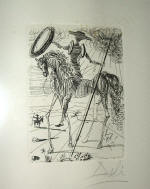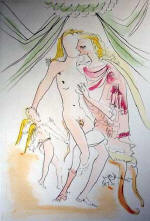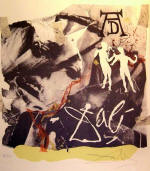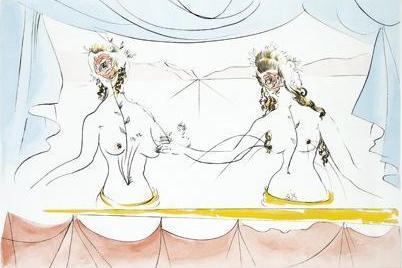|
Homage to
Albrecht Durer Venus, Mars et Cupidon 1971
Signed &
Numbered |
Homage to
Albrecht Durer
1971 pencil
signed and marked HC |
Purgatory Canto Dante Re-Awakes |
The Women
of the Renaissance
Signed &
Numbered
Les Dames
de la Renaissance |
 |
 |
Dali prints
were created in different techniques: mostly etchings, but also
engravings, woodcuts, lithographs and mixed-media. His graphic works
were published either as individual sheets or as complete series or as
portfolios or as illustrations in limited-edition books.
Information about Salvador Dali prints and other works have been
collected for over forty years by Alfred Field, director of Dali
Archives Ltd, New York, with the approval of the artist. In 1994,
Alfred Field published The Official Catalog of the Graphic Works of
Salvador Dali.
The catalog raisonne lists 1700 genuine and authentic graphic works.
Albert Field groups them into original and cooperative prints. He
defines original prints as those created by Salvador himself and
cooperative prints as those supervised and approved by Dali...
more at artelino GmbH |
|
Salvador Domingo Felipe Jacinto Dalí i Domènech, 1st Marquis of Púbol was
a prominent Spanish Catalan surrealist painter.
Born
in in the small agricultural town of Figueres, Spain. Figueres
is located in the foothills of the Pyrenees, only sixteen miles from
the French border in the principality of Catalonia. The son of a
prosperous notary, Salvador Dali spent his boyhood in Figueres and at
the family's summer home in the coastal fishing village of Cadaques
where his parents built his first studio. As an adult, he made his
home with his wife Gala in nearby Port Lligat. Many of his paintings
reflect his love of this area of Spain.
The young Salvador Dali
attended the San Fernando Academy of Fine Arts in Madrid. Early
recognition of Salvador Dali's talent came with his first one-man show
in Barcelona in 1925. He became internationally known when three of
his paintings, including The Basket of Bread (now in the Museum's
collection), were shown in the third annual Carnegie International
Exhibition in Pittsburgh in 1928.
The following year, Dalí held
his first one-man show in Paris. He also joined the surrealists, led
by former Dadaist Andre Breton. That year, Dalí met Gala Eluard when
she visited him in Cadaques with her husband, poet Paul Eluard. She
became Dalí's lover, muse, business manager, and chief inspiration.
Dalí soon became a leader of
the surrealist movement. His painting, The Persistance of Memory, with
the soft or melting watches is still one of the best-known surrealist
works. But as the war approached, the apolitical Dalí clashed with the
surrealists and was "expelled" from the surrealist group during a
"trial" in 1934. He did however, exhibit works in international
surrealist exhibitions throughout the decade but by 1940, Dalí was
moving into a new style that eventually became known as his "classic"
period, demonstrating a preoccupation with science and religion.
Dalí and Gala escaped from
Europe during World War II, spending 1940-48 in the United States.
These were very important years for the artist. The Museum of Modern
Art in New York gave Dali his first major retrospective exhibit in
1941. This was followed in 1942 by the publication of Dali's
autobiography, The Secret Life of Salvador Dali.
As Dalí moved away from
Surrealism and into his classic period, he began his series of 19
large canvases, many concerning scientific, historical or religous
themes. Among the best known of these works are The Hallucinogenic
Toreador, and The Discovery of America by Christopher Columbus in the
museum's collection, and The Sacrament of the Last Supper in the
collection of the National Gallery in Washington, D.C.
In 1974, Dalí opened the Teatro
Museo in Figueres, Spain. This was followed by retrospectives in Paris
and London at the end of the decade. After the death of his wife,
Gala, in 1982, Dalí's health began to fail. It deteriorated further
after he was burned in a fire in his home in Pubol in 1984. Two years
later, a pace-maker was implanted. Much of this part of his life was
spent in seclusion, first in Pubol and later in his apartments at
Torre Galatea, adjacent to the Teatro Museo. Salvador Dalí died on
January 23, 1989 in Figueres from heart failure with respiratory
complications.
As an artist, Salvador Dalí was
not limited to a particular style or media. The body of his work, from
early impressionist paintings through his transitional surrealist
works, and into his classical period, reveals a constantly growing and
evolving artist. Dalí worked in all media, leaving behind a wealth of
oils, watercolors, drawings, graphics, and sculptures, jewels and
objects of all descriptions.
Whether working from pure
inspiration or on a commissioned illustration, Dalí's matchless
insight and symbolic complexity are apparent. Above all, Dalí was a
superb draftsman. His excellence as a creative artist will always set
a standard for the art of the twentieth century. GoAntiques
Salvador Dali - Mike Wallace
interview 1958 - Part 1/2
|
|
Gallery by Appointment
Zaidan Gallery, 7881
Decarie Blvd. Suite 405, Montreal, Quebec, H4P2H2 Canada
Phone: 1(514)944-7027, email:
info@zaidan.ca
This site contains
links to other Internet sites. These links are not endorsements of
any products or services in such sites, and no information in such
site has been endorsed or approved by Zaidan International.
Payment Details: Pay Pal and most
major Credit Cards, Money order/Cashier checks Personal check Wire
Transfer
Shipping/Handling: To Be Determined
Zaidan
Gallery is not responsible for typographical errors or omissions. |




